Living off grid and the English houses where you can
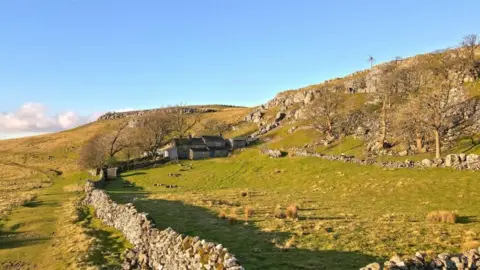 Fisher Hopper
Fisher HopperLooking to avoid high energy bills, lengthy mortgages and other people? Off-grid living could be for you.
Last week we reported on a 400-year-old home on one of North Yorkshire's Three Peaks that is not connected to mains supplies and only accessible by 4X4. Crina Bottom is up for sale and could be yours for £750,000.
But what is it really like to go off grid? BBC News spoke to people who have made the leap, and found some of the current options that are on the market.
'My kids were slightly embarrassed'
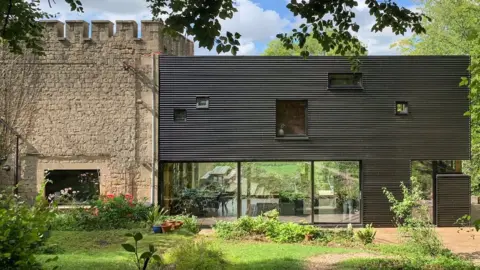 Jim Stephenson
Jim Stephenson In 2005, architect Piers Taylor and his wife Sue Philips took their first steps towards being energy independent when they built their own home in a remote woodland with no car access.
The project involved extending an 18th Century stone schoolhouse on the outskirts of Bath to create a modern family home with an off-grid heating system.
The new home was connected to mains electricity, but not gas, so Mr Taylor installed a wood-fired boiler to provide heating and hot water.
But not only was it "incredibly labour-intensive" to source the wood from the surrounding forest, he said, but burning it also emits carbon.
"Typically it was me doing all the chain-sawing, and then, as my children got older, them helping with the splitting and stacking," he said.
"The kids just got fed up. They were slightly embarrassed, all their friends lived in conventional houses."
Now, the house's energy efficiency is in line with current standards after Mr Taylor's practice, Invisible Studio, upgraded the walls and windows to make them more insulated, and installed underfloor heating powered by electricity.
"The insulation and airtightness performs as well as a passive house," he said, referring to a standard of home that maintains a comfortable temperature using less energy than most.
This has halved their demand for wood, and the house now also provides its own electricity via solar panels and a battery.
But if you're thinking of building or retrofitting an off-grid house yourself, his biggest piece of advice is to "reduce your demand".
"We design buildings that hardly need heating, that's the first thing. Second, you want to reduce your lighting demand."
The student-built eco-home
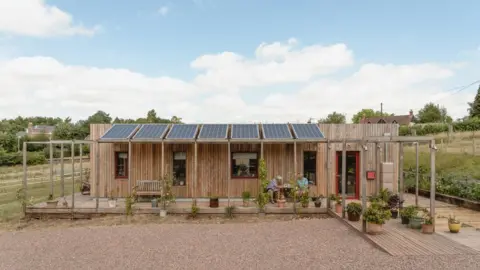 Andreas Billman
Andreas BillmanNest House, an eco-home in Herefordshire, is an example of off-grid technologies on a budget.
Designed by architects Studio Bark, and built for retired couple Francine and Stephen Burns at a total cost of £280,000, the property is made from a prefabricated structure of timber cassettes.
Students constructed the home as part of an education programme, installing second-hand solar panels from an old solar farm to form a veranda that provides electricity, and an experimental system that combines infrared panels with sensors to give energy-efficient heating.
Mr and Mrs Burns can only live off-grid for part of the year as their current system cannot fully meet their power demands, so they still require some mains power in the winter.
But with a battery storing power from the solar panels, in the event of a power cut Francine and Stephen would have four days of power that would allow most of their appliances to be used.
"Get more solar panels than you think you need," she advised would-be off-gridders. "The construction design wouldn't make it easy to put any more on at this point."
The house was designed with accessibility in mind due to Francine's mobility issues. It has no steps, for example, which has made it "future-proofed" for their potential needs in the years ahead.
Since the project was started, Stephen was diagnosed with advanced Alzheimer's, but the house's design makes life easier for him "because of the way it flows", Francine said.
"From the kitchen, through to the sitting room, straight through to the bedroom, I can easily see or hear what he's doing... he's not isolated, he's not going to get lost anywhere."
If you fancy the off-grid experience but don't plan on building your own home, here are some of the homes currently on the market in England.
Higher Halstock - £850,000
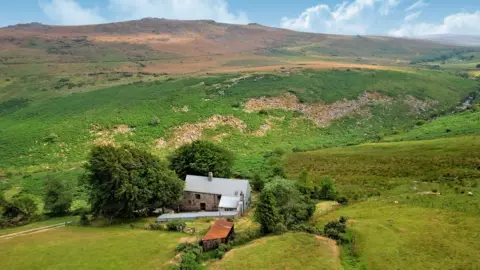 Godfrey Short & Squire
Godfrey Short & SquireHigher Halstock in Dartmoor National Park is described by estate agent Godfrey Short and Squire as a "grade II listed example of a late Devon longhouse".
Estimated to have been built around 1700 out of granite fieldstone, it is a two-bedroom cottage with an attached barn.
The £850,000 property has a bespoke wind turbine-driven electrical system, a private spring-fed water supply, woodstoves for non-fossil fuel heating as well as an oil-fired stove serving hot water and central heating.
Sat in the centre of over half an acre of land, the house is approached from rough tracks across the moor and via two field gates.
Autumn Wood - £600,000
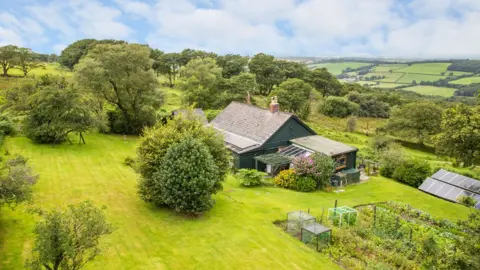 Marcus Wrey
Marcus WreyAutumn Wood has been on the market for more than two years and is currently listed at £600,000.
Situated on a third of an acre on the edge of Dartmoor, famed for its hundreds of square miles of unspoilt scenery, its residents would have no close neighbours.
With electricity coming from solar panels and a generator, and a private water supply, the house's only mains services are telephone and broadband.
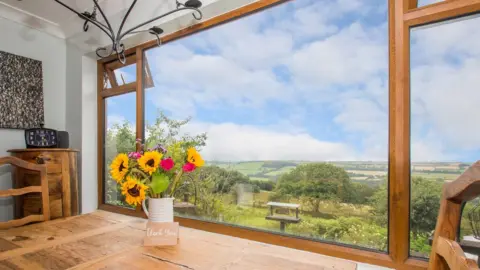 Marcus Wrey
Marcus WreyThe timber-constructed house was reportedly made in a London workshop and then sold by Harrods, and is located on the edge of a Saxon settlement that previously formed part of the Luxmoore Estate.
Crina Bottom - £750,000
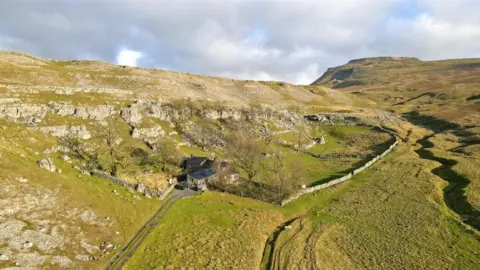 Fisher Hopper
Fisher HopperCrina Bottom, near Ingleton, is a "one-of-a-kind" house halfway up one of the famous Three Peaks in North Yorkshire.
Currently on the market for £750,000, the 400-year-old house is only accessible by a 4x4 vehicle as it is perched on the side of Ingleborough in the Yorkshire Dales, with the nearest public road about 1.5 miles (2.4km) away.
Estate agent Darren Spratt, who is marketing Crina Bottom, said there had already been a "reasonable amount of interest" in the property.
The four-bedroom house is not connected to any mains supplies, with electricity generated through a wind turbine and water sourced from the mountainside.
A biomass boiler, fed by wood pellets, is used to heat the property.
